Abstract
The cellular basis of the impaired autologous mixed leukocyte reaction (AMLR) in patients with systemic lupus erythematosus (SLE) was investigated. Non-T cells from normal subjects and from SLE patients were fractionated into low and high density subpopulations. SLE patients were found to have an increased proportion of low density to high density non-T cells when compared to normal subjects. Although normal low-density non-T cells were highly enriched in AMLR stimulatory capacity, SLE low-density non-T cells induced minimal proliferation by autologous T cells. Brief incubation of SLE non-T cells with phorbol myristate acetate or formalin-treated Staphylococcus aureus resulted in marked augmentation of the capacity of those non-T cells to stimulate an AMLR, although the magnitude of the activated non-T cell-induced AMLR did not achieve that observed in normal subjects. No significant alterations in the expression of Ia molecules on the surface of the non-T cells were detected after in vitro activation. These experiments support the hypothesis that the impaired capacity of SLE T lymphocytes to proliferate in response to autologous non-T cells may in part represent a failure of SLE non-T cells to present an appropriate stimulus for the generation of a T cell response.
Full text
PDF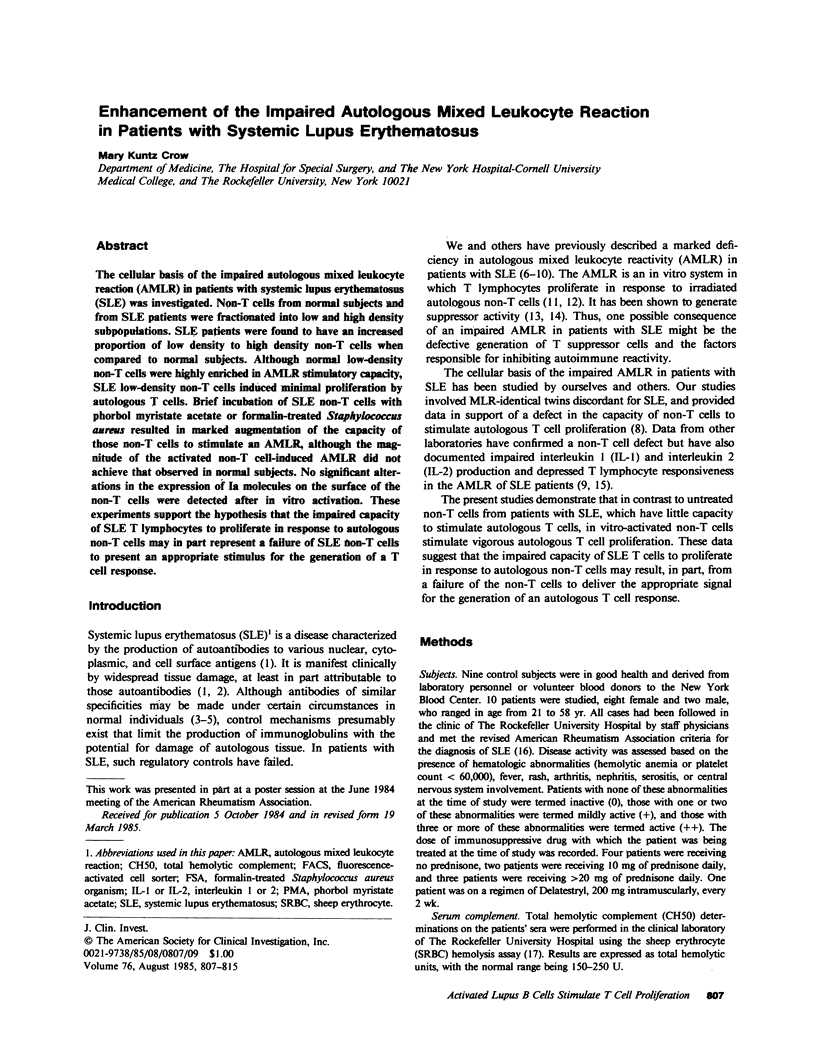
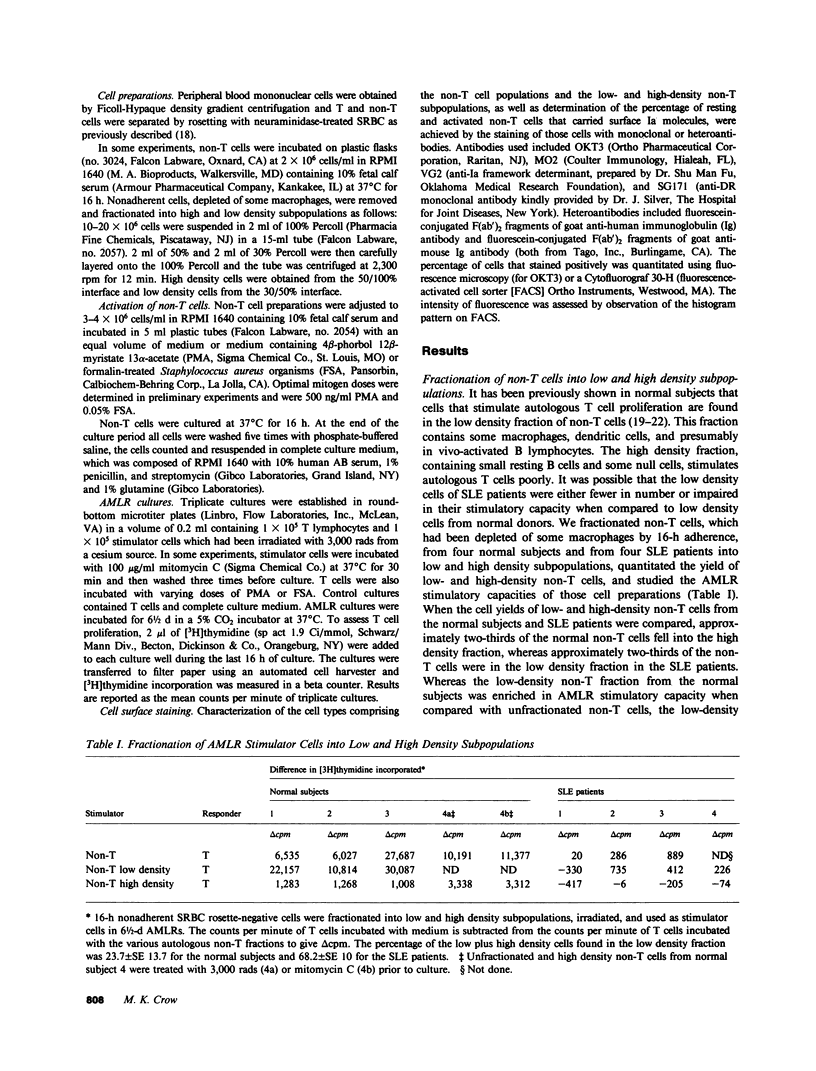
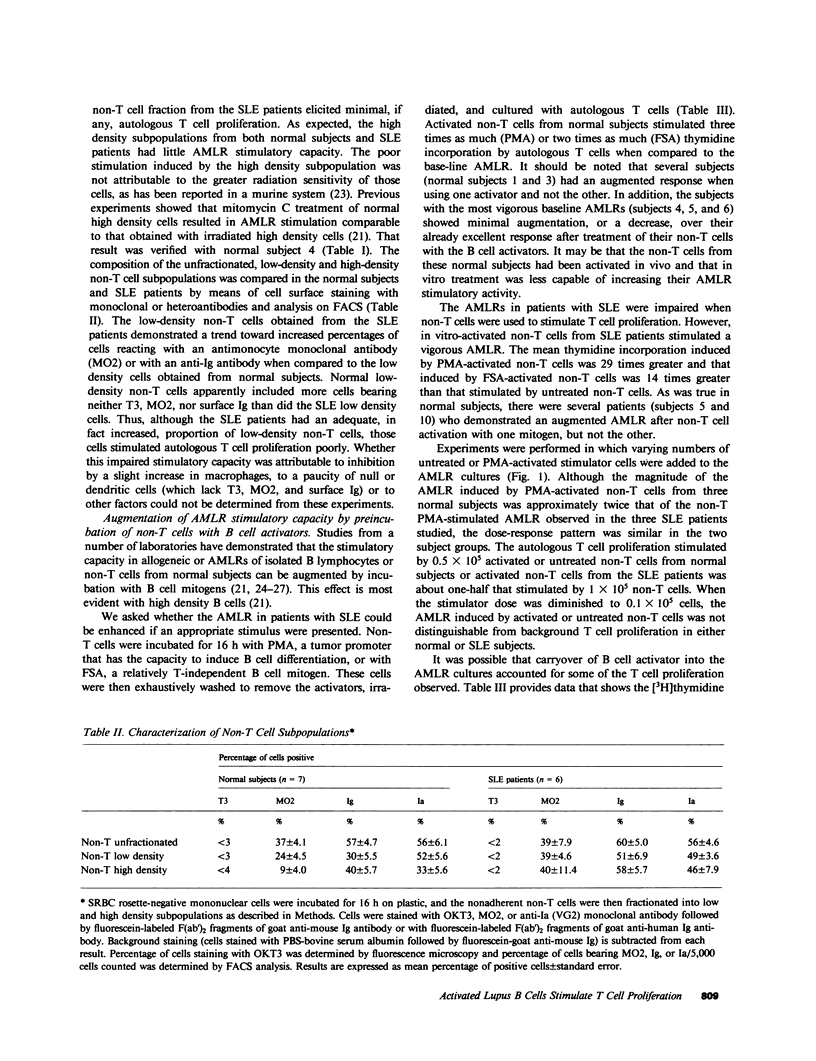
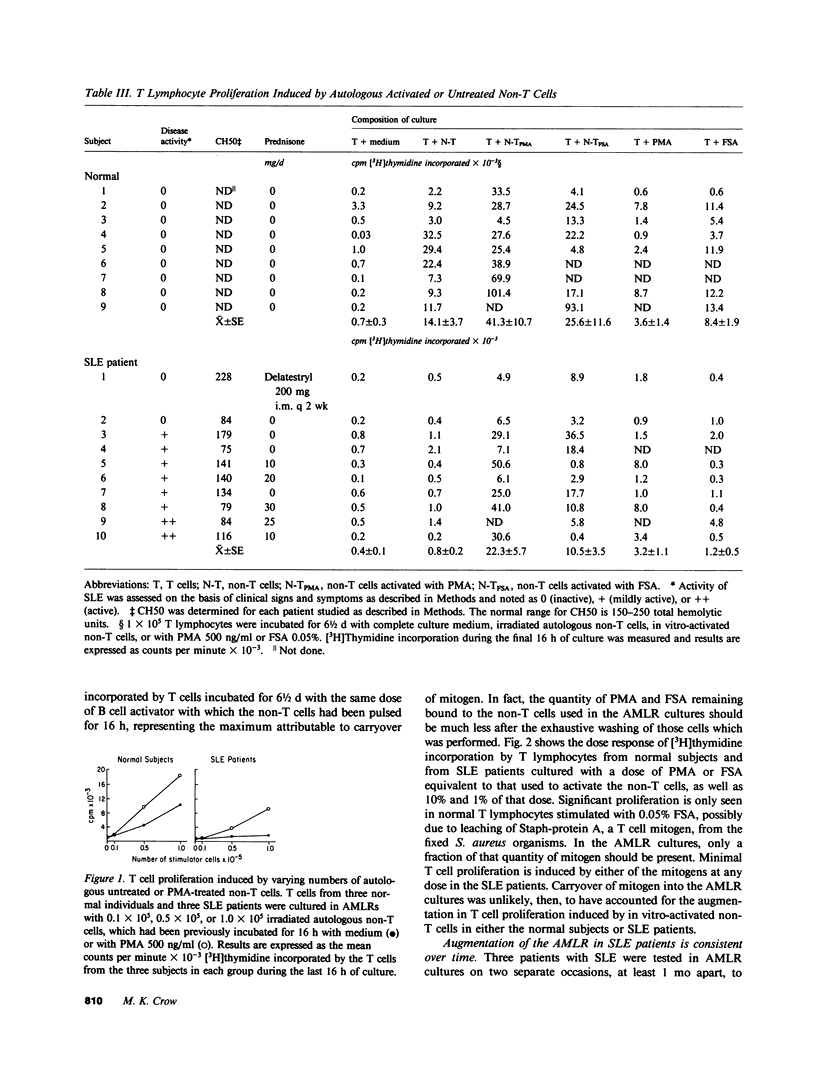
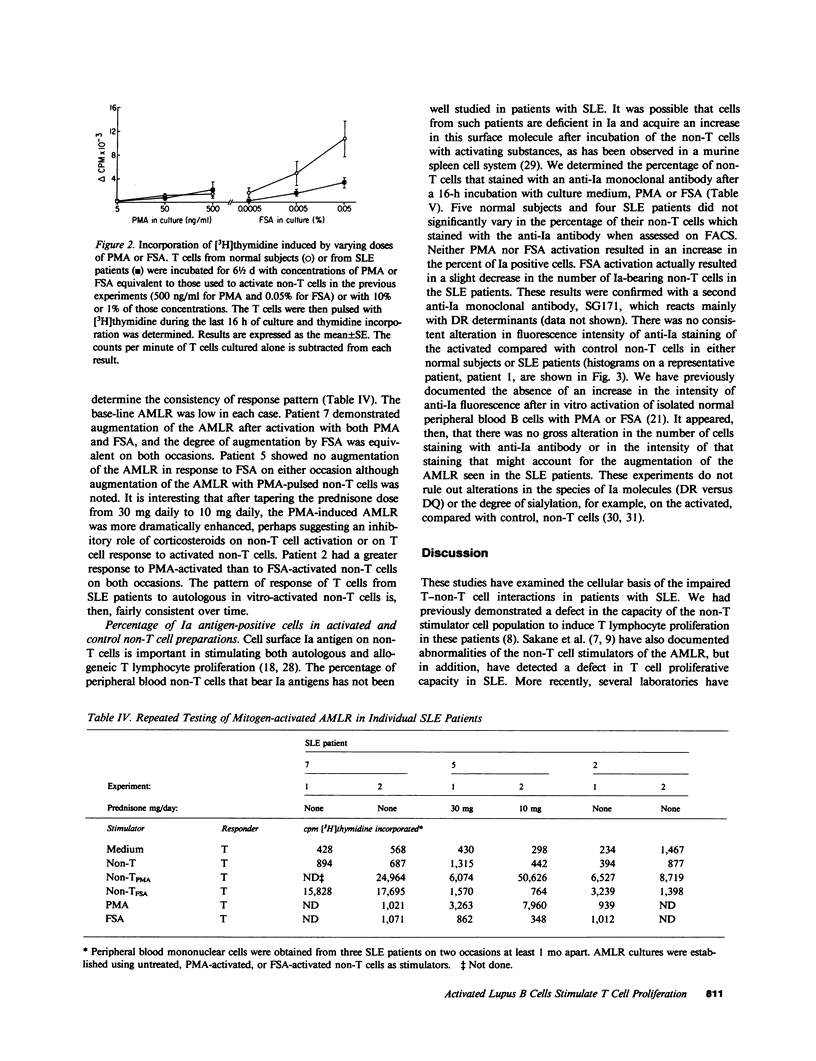
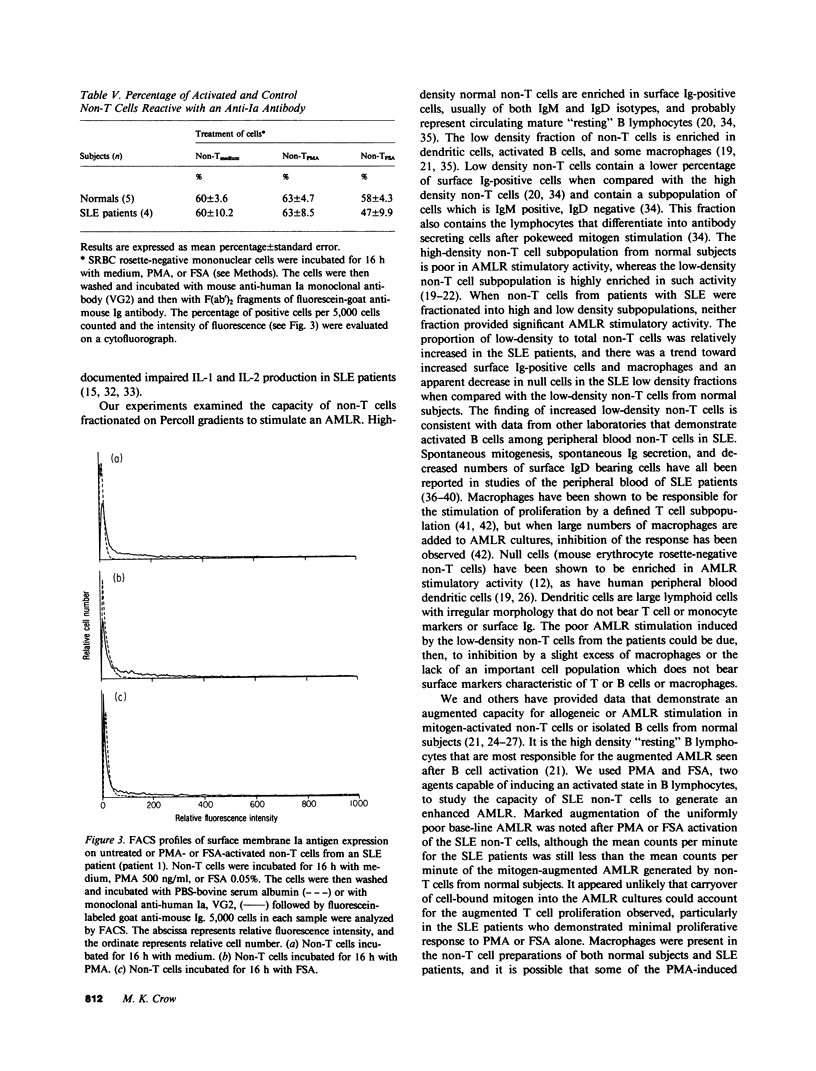
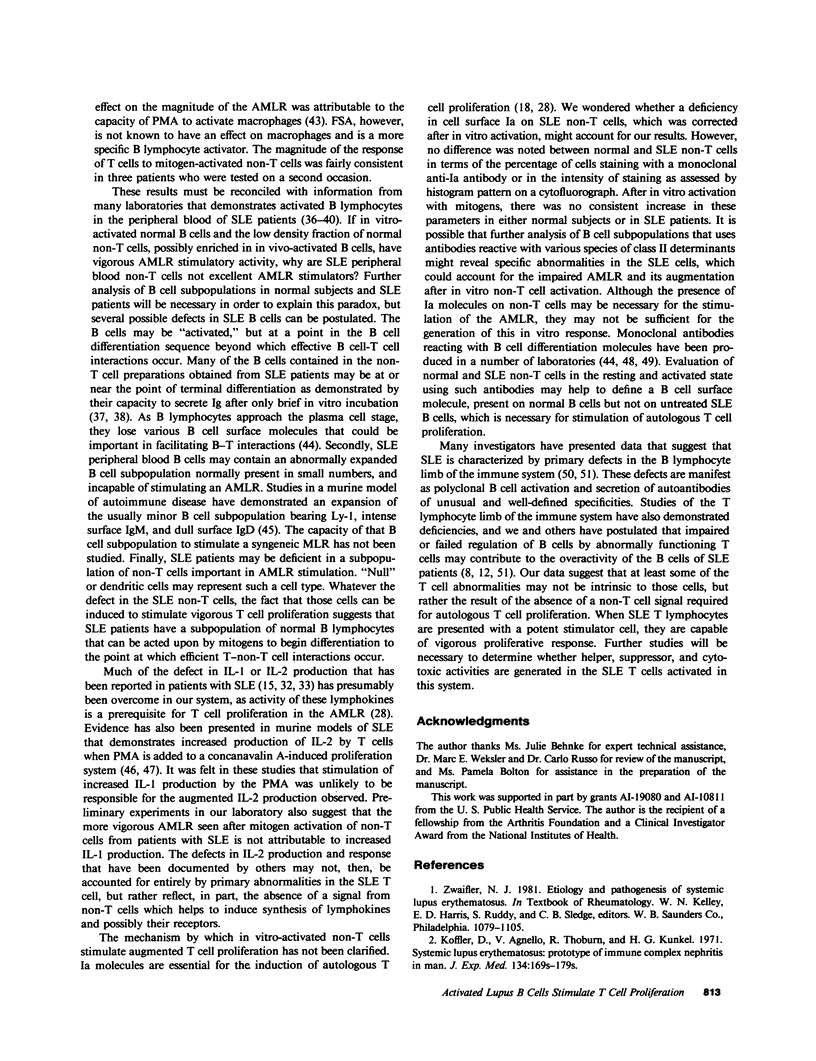
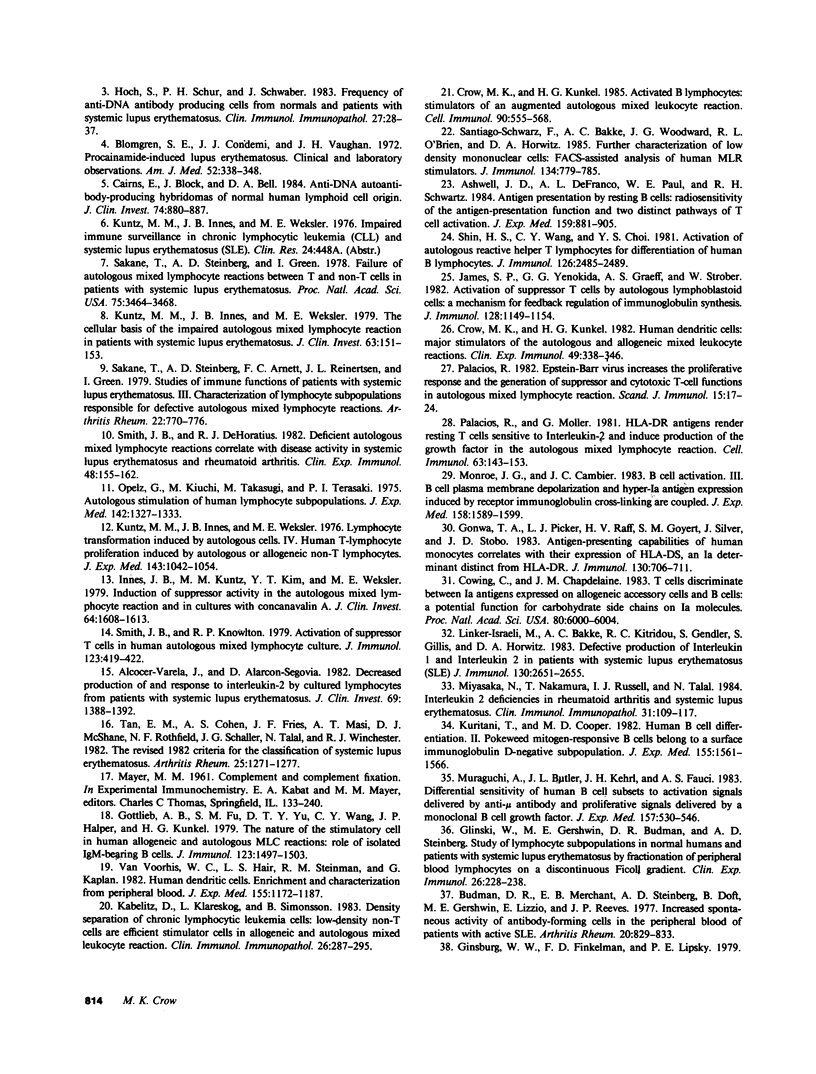
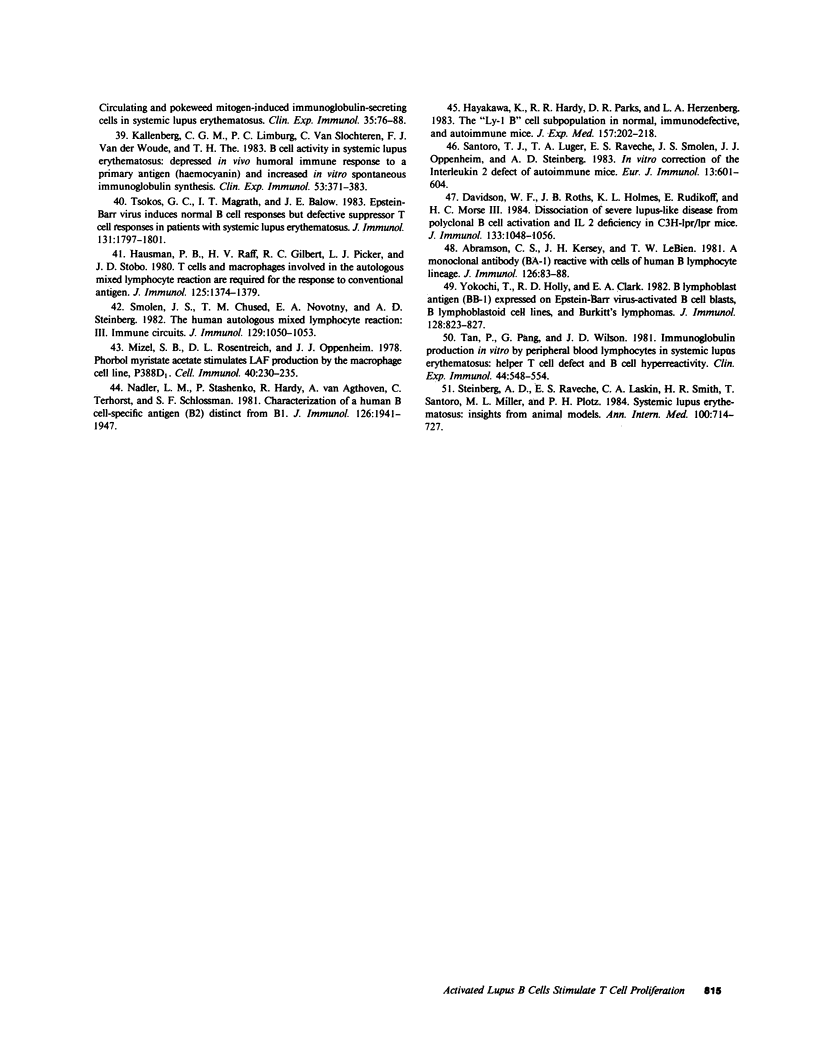
Selected References
These references are in PubMed. This may not be the complete list of references from this article.
- Abramson C. S., Kersey J. H., LeBien T. W. A monoclonal antibody (BA-1) reactive with cells of human B lymphocyte lineage. J Immunol. 1981 Jan;126(1):83–88. [PubMed] [Google Scholar]
- Alcocer-Varela J., Alarcón-Segovia D. Decreased production of and response to interleukin-2 by cultured lymphocytes from patients with systemic lupus erythematosus. J Clin Invest. 1982 Jun;69(6):1388–1392. doi: 10.1172/JCI110579. [DOI] [PMC free article] [PubMed] [Google Scholar]
- Ashwell J. D., DeFranco A. L., Paul W. E., Schwartz R. H. Antigen presentation by resting B cells. Radiosensitivity of the antigen-presentation function and two distinct pathways of T cell activation. J Exp Med. 1984 Mar 1;159(3):881–905. doi: 10.1084/jem.159.3.881. [DOI] [PMC free article] [PubMed] [Google Scholar]
- Blomgren S. E., Condemi J. J., Vaughan J. H. Procainamide-induced lupus erythematosus. Clinical and laboratory observations. Am J Med. 1972 Mar;52(3):338–348. doi: 10.1016/0002-9343(72)90021-6. [DOI] [PubMed] [Google Scholar]
- Budman D. R., Merchant E. B., Steinberg A. D., Doft B., Gershwin M. E., Lizzio E., Reeves J. P. Increased spontaneous activity of antibody-forming cells in the peripheral blood of patients with active SLE. Arthritis Rheum. 1977 Apr;20(3):829–833. doi: 10.1002/art.1780200312. [DOI] [PubMed] [Google Scholar]
- Cairns E., Block J., Bell D. A. Anti-DNA autoantibody-producing hybridomas of normal human lymphoid cell origin. J Clin Invest. 1984 Sep;74(3):880–887. doi: 10.1172/JCI111505. [DOI] [PMC free article] [PubMed] [Google Scholar]
- Cowing C., Chapdelaine J. M. T cells discriminate between Ia antigens expressed on allogeneic accessory cells and B cells: a potential function for carbohydrate side chains on Ia molecules. Proc Natl Acad Sci U S A. 1983 Oct;80(19):6000–6004. doi: 10.1073/pnas.80.19.6000. [DOI] [PMC free article] [PubMed] [Google Scholar]
- Crow M. K., Kunkel H. G. Activated B lymphocytes: stimulators of an augmented autologous mixed leukocyte reaction. Cell Immunol. 1985 Feb;90(2):555–568. doi: 10.1016/0008-8749(85)90220-5. [DOI] [PubMed] [Google Scholar]
- Crow M. K., Kunkel H. G. Human dendritic cells: major stimulators of the autologous and allogeneic mixed leucocyte reactions. Clin Exp Immunol. 1982 Aug;49(2):338–346. [PMC free article] [PubMed] [Google Scholar]
- Davidson W. F., Roths J. B., Holmes K. L., Rudikoff E., Morse H. C., 3rd Dissociation of severe lupus-like disease from polyclonal B cell activation and IL 2 deficiency in C3H-lpr/lpr mice. J Immunol. 1984 Aug;133(2):1048–1056. [PubMed] [Google Scholar]
- Ginsburg W. W., Finkelman F. D., Lipsky P. E. Circulating and pokeweed mitogen-induced immunoglobulin-secreting cells in systemic lupus erythematosus. Clin Exp Immunol. 1979 Jan;35(1):76–88. [PMC free article] [PubMed] [Google Scholar]
- Gonwa T. A., Picker L. J., Raff H. V., Goyert S. M., Silver J., Stobo J. D. Antigen-presenting capabilities of human monocytes correlates with their expression of HLA-DS, an Ia determinant distinct from HLA-DR. J Immunol. 1983 Feb;130(2):706–711. [PubMed] [Google Scholar]
- Gottlieb A. B., Fu S. M., Yu D. T., Wang C. Y., Halper J. P., Kunkel H. G. The nature of the stimulatory cell in human allogeneic and autologous MLC reactions; role of isolated IgM-bearing B cells. J Immunol. 1979 Oct;123(4):1497–1503. [PubMed] [Google Scholar]
- Hausman P. B., Raff H. V., Gilbert R. C., Picker L. J., Stobo J. D. T cells and macrophages involved in the autologous mixed lymphocyte reaction are required for the response to conventional antigen. J Immunol. 1980 Sep;125(3):1374–1379. [PubMed] [Google Scholar]
- Hayakawa K., Hardy R. R., Parks D. R., Herzenberg L. A. The "Ly-1 B" cell subpopulation in normal immunodefective, and autoimmune mice. J Exp Med. 1983 Jan 1;157(1):202–218. doi: 10.1084/jem.157.1.202. [DOI] [PMC free article] [PubMed] [Google Scholar]
- Hoch S., Schur P. H., Schwaber J. Frequency of anti-DNA antibody producing cells from normals and patients with systemic lupus erythematosus. Clin Immunol Immunopathol. 1983 Apr;27(1):28–37. doi: 10.1016/0090-1229(83)90053-3. [DOI] [PubMed] [Google Scholar]
- Innes J. B., Kuntz M. M., Kim Y. T., Weksler M. E. Induction of suppressor activity in the autologous mixed lymphocyte reaction and in cultures with concanavalin A. J Clin Invest. 1979 Dec;64(6):1608–1613. doi: 10.1172/JCI109622. [DOI] [PMC free article] [PubMed] [Google Scholar]
- James S. P., Yenokida G. G., Graeff A. S., Strober W. Activation of suppressor T cells by autologous lymphoblastoid cells: a mechanism for feedback regulation of immunoglobulin synthesis. J Immunol. 1982 Mar;128(3):1149–1154. [PubMed] [Google Scholar]
- Kabelitz D., Klareskog L., Simonsson B. Density separation of chronic lymphocytic leukemia cells: low-density non-T cells are efficient stimulator cells in allogeneic and autologous mixed leukocyte reaction. Clin Immunol Immunopathol. 1983 Feb;26(2):287–295. doi: 10.1016/0090-1229(83)90147-2. [DOI] [PubMed] [Google Scholar]
- Kallenberg C. G., Limburg P. C., Van Slochteren C., Van der Woude F. J., The T. H. B cell activity in systemic lupus erythematosus: depressed in vivo humoral immune response to a primary antigen (haemocyanin) and increased in vitro spontaneous immunoglobulin synthesis. Clin Exp Immunol. 1983 Aug;53(2):371–383. [PMC free article] [PubMed] [Google Scholar]
- Koffler D., Agnello V., Thoburn R., Kunkel H. G. Systemic lupus erythematosus: prototype of immune complex nephritis in man. J Exp Med. 1971 Sep 1;134(3 Pt 2):169s–179s. [PubMed] [Google Scholar]
- Kuntz M. M., Innes J. B., Weksler M. E. Lymphocyte transformation induced by autologous cells. IV. Human T-lymphocyte proliferation induced by autologous or allogeneic non-T lymphocytes. J Exp Med. 1976 May 1;143(5):1042–1054. doi: 10.1084/jem.143.5.1042. [DOI] [PMC free article] [PubMed] [Google Scholar]
- Kuntz M. M., Innes J. B., Weksler M. E. The cellular basis of the impaired autologous mixed lymphocyte reaction in patients with systemic lupus erythematosus. J Clin Invest. 1979 Jan;63(1):151–153. doi: 10.1172/JCI109270. [DOI] [PMC free article] [PubMed] [Google Scholar]
- Kuritani T., Cooper M. D. Human B cell differentiation. II. Pokeweed mitogen-responsive B cells belong to a surface immunoglobulin D-negative subpopulation. J Exp Med. 1982 May 1;155(5):1561–1566. doi: 10.1084/jem.155.5.1561. [DOI] [PMC free article] [PubMed] [Google Scholar]
- Linker-Israeli M., Bakke A. C., Kitridou R. C., Gendler S., Gillis S., Horwitz D. A. Defective production of interleukin 1 and interleukin 2 in patients with systemic lupus erythematosus (SLE). J Immunol. 1983 Jun;130(6):2651–2655. [PubMed] [Google Scholar]
- Miyasaka N., Nakamura T., Russell I. J., Talal N. Interleukin 2 deficiencies in rheumatoid arthritis and systemic lupus erythematosus. Clin Immunol Immunopathol. 1984 Apr;31(1):109–117. doi: 10.1016/0090-1229(84)90195-8. [DOI] [PubMed] [Google Scholar]
- Mizel S. B., Rosenstreich D. L., Oppenheim J. J. Phorbol myristic acetate stimulates LAF production by the macrophage cell line, P388D. Cell Immunol. 1978 Sep 15;40(1):230–235. doi: 10.1016/0008-8749(78)90330-1. [DOI] [PubMed] [Google Scholar]
- Monroe J. G., Cambier J. C. B cell activation. III. B cell plasma membrane depolarization and hyper-Ia antigen expression induced by receptor immunoglobulin cross-linking are coupled. J Exp Med. 1983 Nov 1;158(5):1589–1599. doi: 10.1084/jem.158.5.1589. [DOI] [PMC free article] [PubMed] [Google Scholar]
- Muraguchi A., Butler J. L., Kehrl J. H., Fauci A. S. Differential sensitivity of human B cell subsets to activation signals delivered by anti-mu antibody and proliferative signals delivered by a monoclonal B cell growth factor. J Exp Med. 1983 Feb 1;157(2):530–546. doi: 10.1084/jem.157.2.530. [DOI] [PMC free article] [PubMed] [Google Scholar]
- Nadler L. M., Stashenko P., Hardy R., van Agthoven A., Terhorst C., Schlossman S. F. Characterization of a human B cell-specific antigen (B2) distinct from B1. J Immunol. 1981 May;126(5):1941–1947. [PubMed] [Google Scholar]
- Opelz G., Kiuchi M., Takasugi M., Terasaki P. I. Autologous stimulation of human lymphocyte subpopulation. J Exp Med. 1975 Nov 1;142(5):1327–1333. doi: 10.1084/jem.142.5.1327. [DOI] [PMC free article] [PubMed] [Google Scholar]
- Palacios R. Epstein-Barr virus increases the proliferative response and the generation of suppressor and cytotoxic T-cell functions in autologous mixed lymphocyte reaction. Scand J Immunol. 1982 Jan;15(1):17–24. doi: 10.1111/j.1365-3083.1982.tb00617.x. [DOI] [PubMed] [Google Scholar]
- Palacios R., Möller G. HLA-DR antigens render resting T cells sensitive to interleukin-2 and induce production of the growth factor in the autologous mixed lymphocyte reaction. Cell Immunol. 1981 Sep 1;63(1):143–153. doi: 10.1016/0008-8749(81)90035-6. [DOI] [PubMed] [Google Scholar]
- Sakane T., Steinberg A. D., Arnett F. C., Reinertsen J. L., Green I. Studies of immune functions of patients with systemic lupus erythematosus. Arthritis Rheum. 1979 Jul;22(7):770–776. doi: 10.1002/art.1780220713. [DOI] [PubMed] [Google Scholar]
- Sakane T., Steinberg A. D., Green I. Failure of autologous mixed lymphocyte reactions between T and non-T cells in patients with systemic lupus erythematosus. Proc Natl Acad Sci U S A. 1978 Jul;75(7):3464–3468. doi: 10.1073/pnas.75.7.3464. [DOI] [PMC free article] [PubMed] [Google Scholar]
- Santiago-Schwarz F., Bakke A. C., Woodward J. G., O'Brien R. L., Horwitz D. A. Further characterization of low density mononuclear cells: FACS-assisted analysis of human MLR stimulators. J Immunol. 1985 Feb;134(2):779–785. [PubMed] [Google Scholar]
- Santoro T. J., Luger T. A., Ravache E. S., Smolen J. S., Oppenheim J. J., Steinberg A. D. In vitro correction of the interleukin 2 defect of autoimmune mice. Eur J Immunol. 1983 Jul;13(7):601–604. doi: 10.1002/eji.1830130717. [DOI] [PubMed] [Google Scholar]
- Shin H. S., Wang C. Y., Choi Y. S. Activation of autologous reactive helper T lymphocytes for differentiation of human B lymphocytes. J Immunol. 1981 Jun;126(6):2485–2489. [PubMed] [Google Scholar]
- Smith J. B., DeHoratius R. J. Deficient autologous mixed lymphocyte reactions correlate with disease activity in systemic lupus erythematosus and rheumatoid arthritis. Clin Exp Immunol. 1982 Apr;48(1):155–162. [PMC free article] [PubMed] [Google Scholar]
- Smith J. B., Knowlton R. P. Activation of suppressor T cells in human autologous mixed lymphocyte culture. J Immunol. 1979 Jul;123(1):419–422. [PubMed] [Google Scholar]
- Smolen J. S., Chused T. M., Novotny E. A., Steinberg A. D. The human autologous mixed lymphocyte reaction. III. Immune circuits. J Immunol. 1982 Sep;129(3):1050–1053. [PubMed] [Google Scholar]
- Steinberg A. D., Raveché E. S., Laskin C. A., Smith H. R., Santoro T., Miller M. L., Plotz P. H. NIH conference. Systemic lupus erythematosus: insights from animal models. Ann Intern Med. 1984 May;100(5):714–727. doi: 10.7326/0003-4819-100-5-714. [DOI] [PubMed] [Google Scholar]
- Tan E. M., Cohen A. S., Fries J. F., Masi A. T., McShane D. J., Rothfield N. F., Schaller J. G., Talal N., Winchester R. J. The 1982 revised criteria for the classification of systemic lupus erythematosus. Arthritis Rheum. 1982 Nov;25(11):1271–1277. doi: 10.1002/art.1780251101. [DOI] [PubMed] [Google Scholar]
- Tan P., Pang G., Wilson J. D. Immunoglobulin production in vitro by peripheral blood lymphocytes in systemic lupus erythematosus: helper T cell defect and B cell hyperreactivity. Clin Exp Immunol. 1981 Jun;44(3):548–554. [PMC free article] [PubMed] [Google Scholar]
- Tsokos G. C., Magrath I. T., Balow J. E. Epstein-Barr virus induces normal B cell responses but defective suppressor T cell responses in patients with systemic lupus erythematosus. J Immunol. 1983 Oct;131(4):1797–1801. [PubMed] [Google Scholar]
- Van Voorhis W. C., Hair L. S., Steinman R. M., Kaplan G. Human dendritic cells. Enrichment and characterization from peripheral blood. J Exp Med. 1982 Apr 1;155(4):1172–1187. doi: 10.1084/jem.155.4.1172. [DOI] [PMC free article] [PubMed] [Google Scholar]
- Yokochi T., Holly R. D., Clark E. A. B lymphoblast antigen (BB-1) expressed on Epstein-Barr virus-activated B cell blasts, B lymphoblastoid cell lines, and Burkitt's lymphomas. J Immunol. 1982 Feb;128(2):823–827. [PubMed] [Google Scholar]


